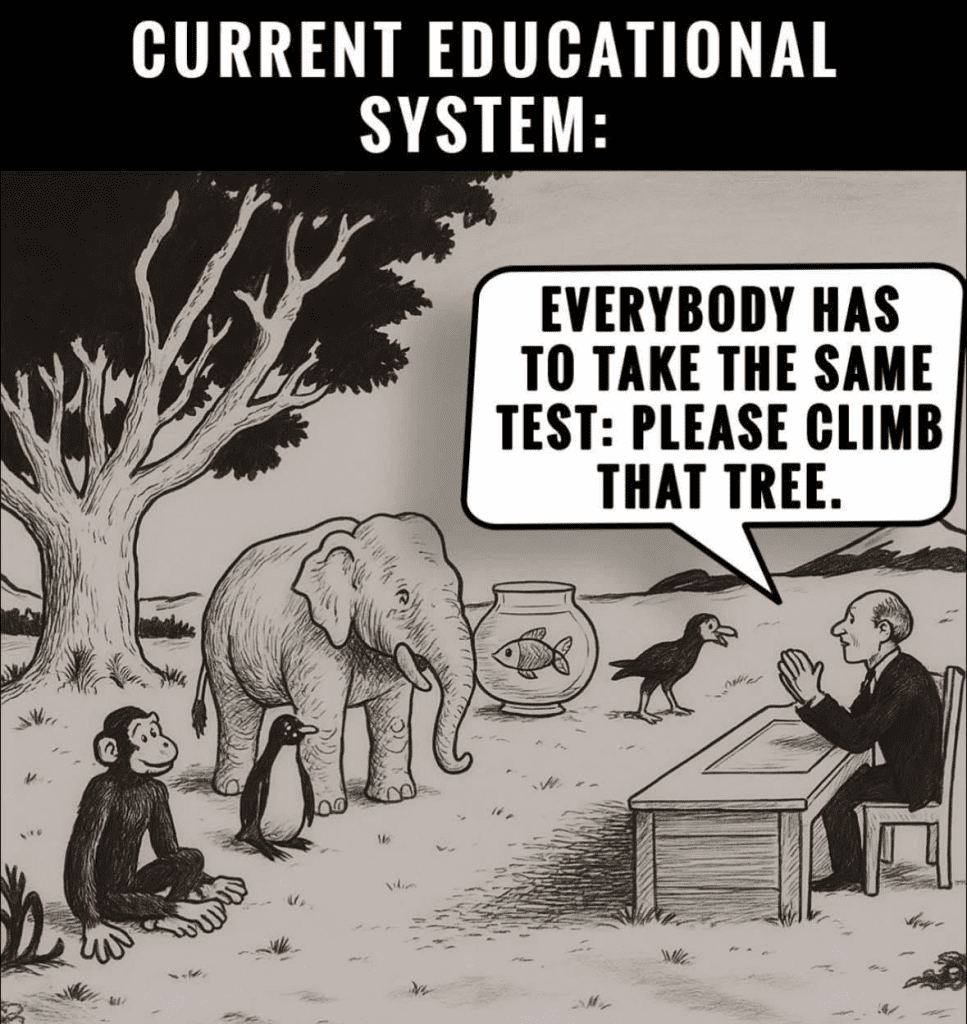Imagine this: a monkey, an elephant, a penguin, a fish, a seal, and a bird are all told to climb a tree to prove their intelligence. Sounds absurd, right? That’s the point. The image you see is more than a cartoon—it’s a powerful metaphor that reflects a harsh truth about our current education system.
We treat all students as if they’re the same, expecting identical results from vastly different minds. And in doing so, we fail many—not because they lack potential, but because the system refuses to see their unique strengths.
The Problem With Standardized Testing

Let’s call it what it is—standardized testing is deeply flawed. When every student is given the same metric to prove their ability, we inevitably favor those whose skills naturally align with the test. Meanwhile, others—just as smart, just as capable—are labeled as underachievers simply because they think, learn, or express themselves differently.
Not every student is meant to climb the same tree. Some are meant to swim, to fly, or to build forests of their own.
A System Built for One Kind of Learner
The traditional classroom rewards the fast processors, the quick writers, the test-takers. But what about the creative thinkers? The hands-on learners? The visual problem solvers? Many students thrive outside of timed exams and rigid curriculums. They ask different questions. They solve problems through trial and error. They explore instead of memorize.
And yet, our education system often ranks them lower—not because they’re less intelligent, but because their intelligence isn’t the kind the system was designed to measure.
The Hidden Cost of “One-Size-Fits-All” Education
When we expect everyone to succeed in the same way, we send a dangerous message: “If you can’t do it our way, you’re not good enough.” This thinking discourages students who might otherwise flourish in creative fields, trades, entrepreneurship, or innovation.
The cost? A generation of kids who grow up believing they’re not smart because they don’t perform well on traditional assessments. Many carry that belief into adulthood, never realizing how gifted they truly are.
Video : Our education system everybody has to give same test…
Why Diverse Intelligence Matters
Psychologist Howard Gardner introduced the idea of multiple intelligences. He argued that intelligence isn’t a single scale, but a spectrum. A child who struggles with math might be brilliant in music. Another who reads slowly might build incredible machines from scratch.
Yet schools often overlook these types of intelligence. We prioritize test scores and GPAs, not curiosity or problem-solving. And that’s a loss—for the student, for the system, and for society as a whole.
What Real Learning Should Look Like
Real learning isn’t about climbing the same tree. It’s about discovering which tree each student is meant to climb—and sometimes, realizing they were meant to explore an entirely different landscape.
A reimagined education system would:
- Personalize learning: Give students room to explore what they’re naturally good at.
- Value creativity and critical thinking: Not just memorization and multiple-choice tests.
- Encourage collaboration: Learning isn’t a race to the top—it’s a shared journey.
- Provide real-world relevance: Teach skills students can apply outside of a classroom.
The Role of Teachers in a Broken System
Let’s be clear—teachers aren’t the problem. Most are doing the best they can within a restrictive system. They care deeply, work long hours, and try to support every student. But many are forced to “teach to the test,” leaving little room for creativity or individualization.
To fix the system, we must empower teachers to teach more freely, to innovate, and to connect with their students beyond the textbook.
Video : This Professor’s Lesson Will Change How You View Time…🤯⏳
Every Student Deserves a Chance to Shine
The message of the image is simple but profound: judging everyone by the same standard is not only unfair—it’s harmful. Intelligence comes in many forms, and education should be the gateway to unlocking that potential, not limiting it.
Some students are monkeys—they’ll ace the tree-climbing test. But others are fish, born to swim in deeper waters. Some are birds, made to soar. Some are elephants, powerful and wise, yet slow to climb. And all of them deserve an education that sees them for who they are.
Conclusion: Time to Rethink What Success Means in Education
If we want a smarter, stronger, more creative society, we have to stop making every student climb the same tree. It’s time to redefine success—not by one test, one score, or one method—but by helping each student discover their own path.
Because real education doesn’t create identical minds. It nurtures unique ones. And that’s how we build a future worth reaching for.


